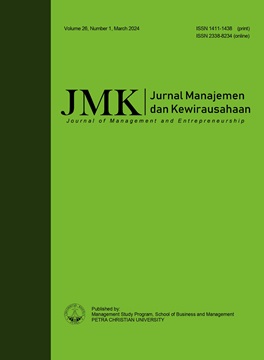GEN Z AND THE FUTURE OF BANKING: AN ANALYSIS OF DIGITAL BANKING ADOPTION
 :
:
https://doi.org/10.9744/jmk.26.1.64-78
Keywords:
UTAUT2, generation Z, digital bankAbstract
In the era of digitalization, a digital bank was the development of banking services. Bank innovation led to innovation in providing various alternative services and improved the ease of transactions for digital banking applications. This study aimed to discuss how digital banks used service features using a modified UTAUT2 approach. The data used was that of respondents belonging to generation Z in Indonesia who used digital banking services on mobile devices. Data analysis was done using PLS-SEM. The findings demonstrated that performance expectancy was the highest variable determining behavioral intention and used behavior. Habit and trust on service provider also predicted intention, and facilitating conditions also had a direct effect on usage behavior when adopting digital banking in generation Z. Surprisingly, effort expectancy, social influence, hedonic motivation, price value, and trust in the internet did not have a significant relationship, for which some possible reasons were explained further. In this article, theoretical and practical implications were also discussed.
References
Al-Azawei, A., & Alowayr, A. (2020). Predicting the intention to use and hedonic motivation for mobile learning: A comparative study in two Middle Eastern countries. Technology in Society, 62, 101325. https://doi.org/10.1016/j.techsoc.2020.101325
Alalwan, A. A., Dwivedi, Y. K., Rana, N. P., & Al-gharabat, R. (2018). Examining factors influencing Jordanian customers’ intentions and adoption of internet banking: Extending UTAUT2 with risk. Journal of Retailing and Consumer Services, 40, 125–138. https://doi.org/10.1016/ j.jretconser.2017.08.026
Alfarizi, M., & Sari, R. K. (2022). Indonesian di¬gi¬tal bank adoption defence determination post-privacy data leakage issues. Presented in the 7th International Workshop on Big Da¬ta and Infor-mation Security, October 1–3, 2022. https://doi.org/10.1109/IWBIS56557.2022.9924813
Ali, M., Raza, S. A., Hakim, F., Puah, C. H., & Chaw, L. Y. (2022). An integrated framework for mobile payment in Pakistan: Drivers, barriers, and facilitators of usage behavior. Journal of Financial Services Marketing. https://doi.org/10.1057/s41264-022-001 99-0
Alnemer, H. A. (2022). Determinants of digital banking adoption in the Kingdom of Saudi Arabia: A technology acceptance model approach. Digital Business, 2(2), 1–8. https://doi.org/10.1016/j.digbus.2022.100037
Anggraeni, R., Hapsari, R., & Muslim, N. A. (2021). Examining factors influencing consumers intention and usage of digital bank¬ing: Evidence from Indonesian digital bank¬ing customers. Asia Pacific Management and Business Application, 009(03), 193–210. https://doi.org/10.21776/ub.apmba.2021.009.03.1
Armansyah, R. F. (2021). Herd behavior in using mobile payment with unified theory of acceptance and use of technology (UTAUT2). Jurnal Manajemen dan Kewirausahaan, 23 (2), 111–128. https://doi.org/10.9744/jmk.23.2.111-128
Bastari, A., Eliyana, A., Syabarrudin, A., Arief, Z., & Emur, A. P. (2020). Digitalization in banking sector: The role of intrinsic motivation. Heliyon, 6(12), 1–12. https://doi.org/10.1016/j.heliyon.2020.e05801
Chinn, W. W. (1998). The partial least squares approach to structural equation modelling. In g. A. Marcoulides (Ed.), Modern methods for business research (pp. 295–336). Lawrence Elbaum Associates.
Davis, F. D. (1989). Perceived usefulness, perceived ease of use, and user acceptance of information technology. MIS Quarterly: Management Information Systems, 13(3), 319–340. https://doi.org/10.2307/249008
Hair Jr., J. F., Matthews, L. M., Matthews, R. L., & Sarstedt, M. (2017). PLS-SEM or CB-SEM: Updated guidelines on which method to use. International Journal of Multivariate Data Analysis, 1(2), 107–123. https://doi.org/10.1504/ijmda.2017.10008574
Hutamargo, C. T., Andajani, E., & Trisnawati, J. D. (2021). The influence of food quality, service quality, pricevalue ratio on customer satisfaction and behavioral intention. Jurnal SMART (Studi Manajemen dan Riset Terapan), 1(1), 36–42. https://doi.org/10.59769/smart.v1i1.9
Indriyarti, E. R., Christian, M., Yulita, H., Aryati, T., & Arsjah, R. J. (2023). Digital bank channel distribution: Predictors of usage attitudes in Jakarta’s Gen z. Journal of Distribution Science, 21(2), 21–34. https://doi.org/10.15722/jds.21.02.202302.21
Kantika, K., Kurniasari, F., & Mulyono, M. (2022). The factors affecting digital bank services adoption using trust as mediating variable. Journal of Business and Management Review, 3(10), 690–704. https://doi.org/10.47153/jbmr310.4882022
Karjaluoto, H., Shaikh, A. A., Saarijärvi, H., & Sa-raniemi, S. (2019). How perceived value drives the use of mobile financial services apps. International Journal of Information Management, 47, 252–261. https://doi.org/10.1016/j.ijinfomgt.2018.08.014
Kaur, S., & Arora, S. (2023). Understanding cus-tomers’ usage behavior towards online banking services: An integrated risk–benefit framework. Journal of Financial Services Marketing. https://doi.org/10.1057/s41264-022-00140-5
Kaur, S. J., Ali, L., Hassan, M. K., & Al-Emran, M. (2021). Adoption of digital banking channels in an emerging economy: Exploring the role of in-branch efforts. Journal of Financial Services Marketing, 26, 107–121. https://doi.org/10.1057/s41264-020-00082-w
Khatimah, H., Susanto, P., & Abdullah, N. L. (2019). Hedonic motivation and social influence on behavioral intention of e-money: The role of payment habit as a mediator. International Journal of Entrepreneurship, 23(1), 1–9.
Kim, S. J., Wang, R. J. H., & Malthouse, E. C. (2015). The effects of adopting and using a brand’s mobile application on customers’ subsequent purchase behavior. Journal of Interactive Marketing, 31(1), 28–41. https://doi.org/10.1016/j.intmar.2015.05.004
Kurniawan, Y., Dumais, S. M., & Anwar, N. (2023). An empirical study on the factors affecting the usage of digital banking in generation Z. Journal of System and Management Sciences, 13(5), 31–48. https://doi.org/10.33168/JSMS.2023.0503
Latan, H., & Ghozali, I. (2014). Partial least squares: Concepts, techniques and applications using WarpPLS 4. Semarang: Diponegoro University Press.
Leong, L. Y., Hew, T. S., Ooi, K. B., & Chong, A. Y. L. (2020). Predicting the antecedents of trust in social commerce – A hybrid structural equation modeling with neural network approach. Journal of Business Research, 110, 24–40. https://doi.org/10.1016/j.jbusre s.2019.11.056
Ligon, E., Malick, B., Sheth, K., & Trachtman, C. (2019). What explains low adoption of digital payment technologies? Evidence from small-scale merchants in Jaipur, India. PLoS ONE, 14(7), e0219450. https://doi.org/10.1371/journal.pone.0219450
Makanyeza, C. (2017). Determinants of consumers’ intention to adopt mobile banking services in Zimbabwe. International Journal of Bank Marketing, 35(6), 997–1017. https://doi.org/10.1108/IJBM-07-2016-0099
Mhlanga, D. (2020). Industry 4.0 in finance: The impact of artificial intelligence (AI) on digital financial inclusion. International Journal of Financial Studies, 8(3), 45. https://doi.org/10.3390/ijfs8030045
Montazemi, A. R., & Qahri-Saremi, H. (2015). Factors affecting adoption of online banking: A meta-analytic structural equation modeling study. Information and Management, 52 (2), 210–226. https://doi.org/10.1016/j.im.2014.11.002
Morosan, C., & DeFranco, A. (2016). Investigating American iPhone users’ intentions to use NFC mobile payments in Hotels. In A. Inversini, & R. Schegg, (Eds.), Information and communication technologies in tourism 2016 (pp 427–440). Springer, Cham. https://doi.org/10.1007/978-3-319-28231-2_31
Mukhopadhyay, J. P. (2021). Determinants of digital technology adoption and financial inclusion in India. Economic and Political Weekly, 56(26–27), 70–76.
Nguyen, T. T., Nguyen, H. T., Mai, H. T., & Tran, T. T. M. (2020). Determinants of digital banking services in Vietnam: Applying utaut2 model. Asian Economic and Financial Review, 10(6), 680–697. https://doi.org/10.18488/journal.aefr.2020.106.680.697
Oye, N. D., Iahad, N. A., & Ab. Rahim, N. (2014). The history of UTAUT model and its impact on ICT acceptance and usage by academicians. Education and Information Technologies, 19, 251–270. https://doi.org/10.1007/s10639-012-9189-9
Parkins, J. R., Rollins, C., Anders, S., & Comeau, L. (2018). Predicting intention to adopt solar technology in Canada: The role of know¬led¬ge, public engagement, and visibility. Ener¬gy Policy, 114, 114–122. https://doi.org/10.1016/j.enpol.2017.11.050
Patil, P., Tamilmani, K., Rana, N. P., & Raghavan, V. (2020). Understanding consumer adoption of mobile payment in India: Extending Meta-UTAUT model with personal innovativeness, anxiety, trust, and grievance redressal. International Journal of Information Management, 54, 102144. https://doi.org/10.1016/j.ijinfomgt. 2020.102144
Pillai, S. P., & Shanmugam, V. (2021). Effect of social influence on behavioural intention to use mobile wallet with the mediating impact of promotional benefits. Design Engineering, 7, 6347–6358.
Pradhina, N. P., & Indrawati. (2019). Measuring tools for analyzing factors influencing continuance intention of digital banking adoption using UTAUT 2 model (A case study of Jenius in Indonesia). International Journal of Business and Management Invention, 8(1), 10–15.
Pratama, R. R. D., & Renny, R. (2022). The role of behavioral intentions to use mobile banking: Application of the UTAUT2 method with security, trust and risk factors. Dinasti Inter-national Journal of Management Sci¬ence, 3(4), 728–741. https://doi.org/10.31933/dijms.v3i4.1141
Rahmiati, R., & Susanto, P. (2022). The effects of social influence, hedonic motivation, and habit on e-money behavioral intention: The role of perceived risk as a moderator. Proceedings of the Eighth Padang International Conference On Economics Education, Economics, Business and Management, Accounting and Entrepreneurship (PICEEBA-8 2021), 184–189. https://doi.org/10.2991/aeb mr.k.220702.027
Raihan, T., & Rachmawati, I. (2019). Analyzing factors influencing continuance intention of e-wallet adoption using UTAUT2 model (A case study of Dana in Indonesia). e-Proceeding of Management, 6(2), 3717–3724.
Sair, S. A., & Danish, R. Q. (2018). Effect of per-formance expectancy and effort expectancy on the mobile commerce adoption intention through personal innovativeness among Pakistani consumers. Pakistan Journal of Commerce and Social Science, 12(2), 501–520.
Santosa, A. D., Taufik, N., Prabowo, F. H. E., & Rahmawati, M. (2021). Continuance intention of baby boomer and X generation as new users of digital payment during COVID-19 pandemic using UTAUT2. Journal of Financial Services Marketing, 26, 259–273. https://doi.org/10.1057/s41264-021-00104-1
Saparudin, M., Rahayu, A., Hurriyati, R., & Sul¬tan, M. A. (2020). Exploring the role of trust in mobile-banking use by Indonesian customer using unified theory of acceptance and usage technology. International Journal of Financial Research, 11(2), 51–60. https://doi.org/10.5430/ijfr.v11n2p51
Saudjhana, A., & Herman, H. (2023). Behavioral intention and adoption of digital bank mobile application among housewives using mixed method approach. Journal of Computer Net-works, Architecture and High Performance Computing, 5(1), 288–301. https://doi.org/10. 47709/cnahpc.v5i1.2185
Seng, W. Q., & Hee, O. C. (2021). Factors influencing the intention to use e-wallet: An extended hedonic-motivation system adoption model. International Journal of Academic Research in Business and Social Sciences, 11(11), 2265–2278. https://doi.org/10.6007/ijarbss/v11-i11/ 11379
Sobti, N. (2019). Impact of demonetization on diffusion of mobile payment service in India: An-tecedents of behavioral intention and adoption using extended UTAUT model. Journal of Advances in Management Research, 16(4), 472–497. https://doi.org/10.1108/JAMR-09-2018-0086
Venkatesh, V., Morris, M. G., Davis, G. B., & Davis, F. D. (2003). User acceptance of information technology: Toward a unified view. MIS Quarterly: Management Information Systems, 27(3), 425–478. https://doi.org/10. 2307/30036540
Venkatesh, V., Thong, J. Y. L., & Xu, X. (2012). Consumer acceptance and use of information technology: Extending the unified theory of acceptance and use of technology. MIS Quarterly: Management Information Systems, 36(1), 157–178. https://doi.org/10.2307/414 10412
Visa. (2022). Consumer payment attitudes study 2022: Navigating anew era in payments. Retrieved from https://www.visa.co.th/dam/VCOM/regional/ ap/documents/visa-cpa-report-smt-2022.pdf
Windasari, N. A., Kusumawati, N., Larasati, N., & Amelia, R. P. (2022). Digital-only banking expe-rience: Insights from gen Y and gen Z. Journal of Innovation & Knowledge, 7(2), 100170. https://doi.org/10.1016/j.jik.2022.1 00170
Wong, S. M., Leong, C. M., & Puah, C. H. (2019). Mobile internet adoption in Malaysian suburbs: The moderating effect of gender. Asian Journal of Business Research, 9(3), 90–114. https://doi. org/10.14707/ajbr.190069
Xie, J., Ye, L., Huang, W., & Ye, M. (2021). Un-derstanding fintech platform adoption: Impacts of perceived value and perceived risk. Journal of Theoretical and Applied Electronic Commerce Research, 16(5), 1893–1911. https://doi.org/10.3390/jtaer16050106
Yadav, M., Joshi, Y., & Rahman, Z. (2015). Mobile social media: The new hybrid element of digital marketing communications. Procedia - Social and Behavioral Sciences, 189, 335–343. https://doi.org/10.1016/j.sbspro.2015.0 3.229
Downloads
Published
How to Cite
Issue
Section
License
Copyright (c) 2024 Chitra Laksmi Rithmaya, Herwin Ardianto, Evi Sistiyarini

This work is licensed under a Creative Commons Attribution 4.0 International License.
Authors who publish on this journal agree to the following terms:
- Authors retain copyright and grant the journal right of first publication with the work simultaneously licensed under a Creative Commons Attribution License that allows others to share the work with an acknowledgement of the work's authorship and initial publication in this journal.
- Authors are able to enter into separate, additional contractual arrangements for the non-exclusive distribution of the journal's published version of the work (e.g., post it to an institutional repository or publish it in a book), with an acknowledgement of its initial publication in this journal.
- Authors are permitted and encouraged to post their work online (e.g., in institutional repositories or on their website) prior to and during the submission process, as it can lead to productive exchanges, as well as earlier and greater citation of published work (See The Effect of Open Access).


















